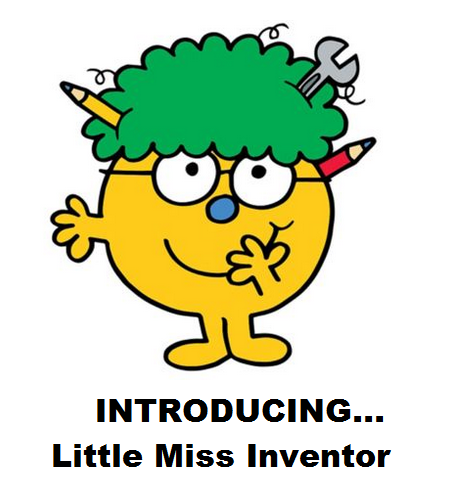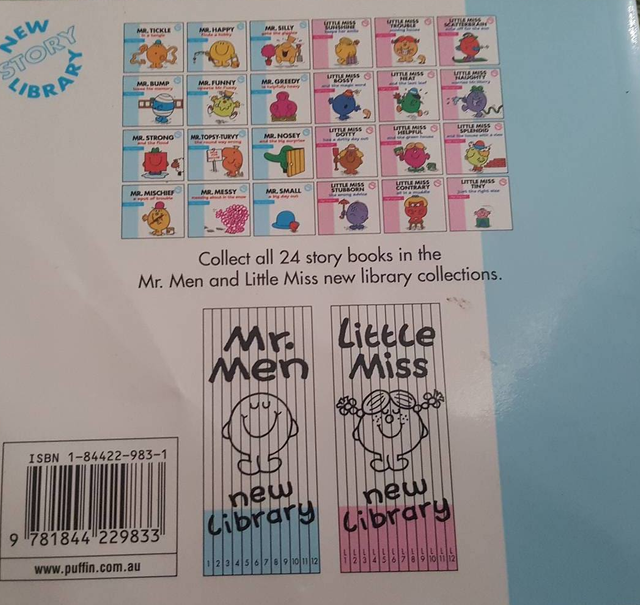Little Miss... Problematic
BOOKS
Little Miss Inventor: A Feminist Character in the Mr Men Universe?
By Melissa Gould, at SoWhat?
December 2, 2017
Misterland has just announced that Little Miss Inventor will join the Mr Men community on March 8, 2018. Created as a positive female role model, and to encourage girl’s into STEM, Little Miss Inventor’s due date coincides with International Women’s Day, British Science Week, (and my birthday!).
Little Miss Inventor will be the 36th Little Miss character in a population of over 90 Mr Men and Little Miss characters. Mr Tickle was the first member of Misterland. He was created by Roger Hargreaves in 1971 when his son asked him what a tickle looks like. The first female character, Little Miss Bossy, wasn’t created until 1981.
Little Miss Inventor is described as,
"intelligent, ingenious and inventive. Her brain is full of ideas, which she turns into extraordinary inventions in a shed at the bottom of her garden. As well as inventing things for herself, she also invents things for her friends, whether it’s a chatter-natter hat for Little Miss Chatterbox or a back-pack-snack-attack fridge for Mr. Greedy." (R1)
Adam Hargreaves, son to Roger Hargreaves and creator of Little Miss Inventor, said,
"it’s also been nice to write a story that promotes a positive role model and to challenge a stereotype, if only in a small way." (R1)
A MIXED RESPONSE
There seems to be two types of reactions to Little Miss Inventor. First, there are those that perceive Little Miss Inventor to be the very character that the series needs to smash the Misterland patriarchy and encourages girls to get into STEM. And then there are those who have no interest in the Mr Men series (often a result from their frustration with the misogynist narratives embraced by the stories).
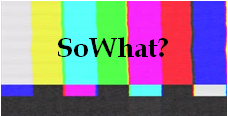
Those who like the book will embrace it, and those who don’t will carry on. No harm done. But this announcement, and the responses to it, got me thinking...
What happens when we pause, step back, and deconstruct Little Miss Inventor? Is she really going to be the next positive role model for little girls around the world?
I wanted to know how a child might respond to Little Miss Inventor, so I decided to have a chat with my 6 year old daughter. We pulled together our Mr Men and Little Miss collection from the bookcase that we had accumulated mainly from gifts and the odd one from when they were part of the McDonald’s Happy Meal. (As a side note, we were still asked at McDonald's if we wanted a ‘boy toy’ or a ‘girl toy’, and received a book where the title character's gender matched that of the toy we requested. The assumption, I assume, being that boy’s don’t like to read stories about girls, and if we don’t give the Little Miss books to the girl customers then who is going to read them)
I began the conversation with my daughter by showing her this image:
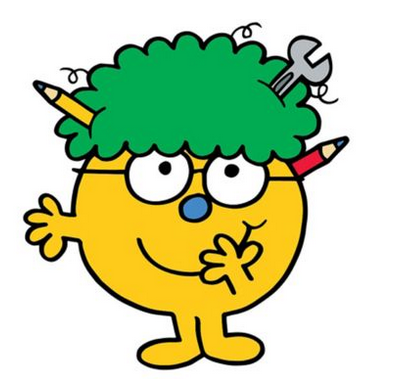
I made sure that the character’s name was not visible and that I didn’t use any pronouns to indicate the character’s gender.
I explained to my daughter that there was going to be a new character in the series and suggested we guess what the character’s name might be.
She responded:
“He’s Mister..... Mr. Creative, Mr. Hypothesis, Mr. Experiment, Mr Fix-It, Mr. Builder. It always has to be a Mister”
Me: Why?
Daughter: Because he’s a boy..... Because every book with a boy on it is a Mister.
Me: How do you know it is a boy?
Daughter: I just think it is.
Me: Why? Are there books (in the series) that are about girls too?
Daughter: Yes.
Me: So, what makes you think it’s a boy?
Daughter: Because we saw on the books there are more green boys then green girls.
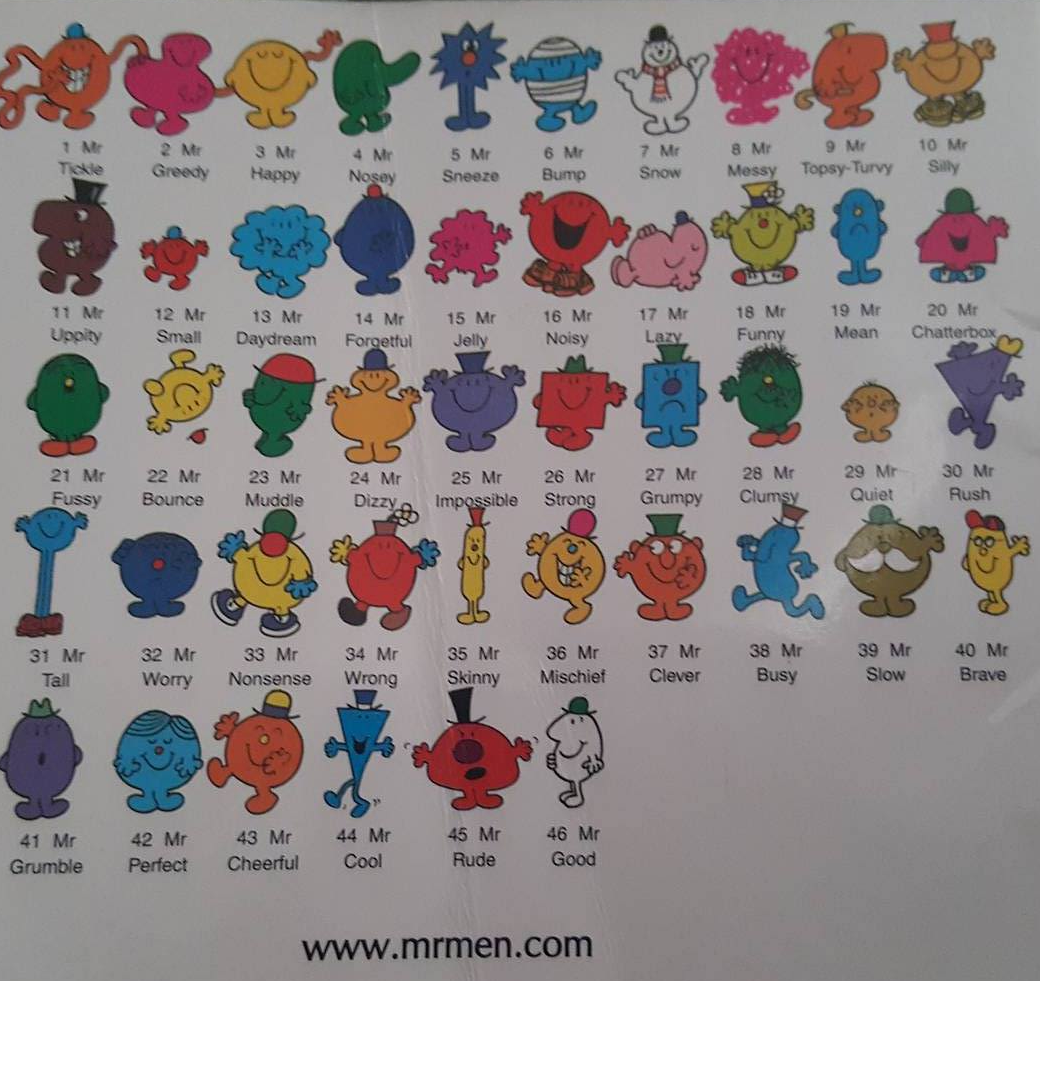
So we did the math:
5 out of 46 Mr Men are green
1 out of 17 Little Miss are green (in the Little Miss Library)
Yes, these are the proper numbers because we were only working on the books that we had and not the entire series. Nonetheless her comments had revealed some interesting points:
- There is a disproportionate number of male and female characters in the series.
- Green was typically attributed to male characters.
- The way characters are represented determines how she understands who the characters are!
Me: So, what if the character is a girl, what do you think she might be called?
Daughter: Mrs. Creative, Mrs...Everything I told you before but just Mrs. at the front. Oh, or Mrs. Fancy, Mrs. Cool, Mrs.
Messy (cause you can be messy in art work), Mrs. Perfect Builder.
Me: What makes you think it’s a girl?
Daughter: silence.... more silence
Me: Ok, final decision: Who is this character?
Daughter: I definitely think it’s a boy. Mr Creative.
Me: Ok, one last thing. Why do you think there is stuff in the character’s hair?
Daughter: Ummm, might be a builder and put there to hold stuff. Oh and did you know that girls can put pencils in their hair to hold so they can do stuff. THE BIG REVEAL
Me: Ok, here we go.... Introducing Little Miss Inventor!
Daughter laughs I’m surprised
Me: Why are you laughing?
Daughter: Because if she was Little Miss Invented then she would have just been invented!
Me: mind blown Good point. What else are you thinking?
Daughter: She sort of looks like a clown. I like her inventing things. I think she could invent something to pop balloons and the kids would be laughing.
Me: And what do you think her book might be about?
Daughter: About clowns, inventing. Maybe she builds stuff like clowns and aeroplanes.
Me: Would you read it?
Daughter: Pretty sure.
How did we go from Mr/Little Miss Hypothesis to a clown?
It all comes down to how we construct meaning using based on how characters are represented through a combination of signs. How we think about and make sense of a character is based on a series of decisions made when the character is created. The decisions about how a character looks, and equally how a character doesn’t look, guide our understanding of who a character is.
What do the choices in the representation of Little Miss Inventor communicate to us?
My mind races with questions:
• Why short hair not long hair, bald, or medium length?
• Why curly hair not wavy or straight hair?
• Why a spanner and pencils in her hair, not a bow, headband, crown, or just hair?
• Why green hair, not pink, blue, yellow, or red?
• Why an inventor not a scientist, student, or worker?
• Why glasses not no glasses?
• Why does the character have 'nerd' attributes, glasses, “uncool” hair etc.
• Why does she have a spanner in her hair? Is this a sign of incompetence? A ‘mad scientist’ perhaps?
• Why are so many traditionally boy codes used to represent a girl?
Consider then, for a moment, how we, or more importantly a child, might respond if the way Little Miss Inventor was represented was altered, even just slightly.
It is admirable that a character was created to be a positive role model for girls, but are good intentions enough? Should we be demanding more?
Why is she still a “Little Miss”? (which sounds so bratty to me). Yes, I understand the branding of the books, but if this character is about progress then why isn’t she a Mrs Inventor (to indicate she is an adult of equal importance to the Mr Men characters), or a Ms. Inventor(to indicate that her marital status isn’t important to her public identity).
Why is her age and marital status or in fact her gender even important to our understanding of her as a character?
Why can’t the character be a Dr., or a Professor? Or why not The Inventor?
What I know for sure is that Little Miss Inventor is actually Little Miss Problematic
THIS ARTICLE IS AN ORIGINAL CONTRIBUTION
Author: Melissa Gould, Ph.D (AUT), MCS, BCS (Hons), BCS.
Dr Melissa Gould holds a Ph.D from the School of Communications at Auckland University of Technology in Auckland, New Zealand. She worked as a Media and Communications Lecturer at the School, and now works as an independent researcher and writer. Her primary research areas include media communication theory and cultural studies that examine religion, gender, childhood and consumerism.
For more articles, check out:
http://www.sowhat.co.nz/
https://www.facebook.com/QuestionSoWhat/
SoWhat? MEDIA MOMENTS AS TEACHABLE MOMENTS
References:
R1: https://www.egmont.co.uk/blog/little-miss-inventor-joins-mr-men-little-misses/
